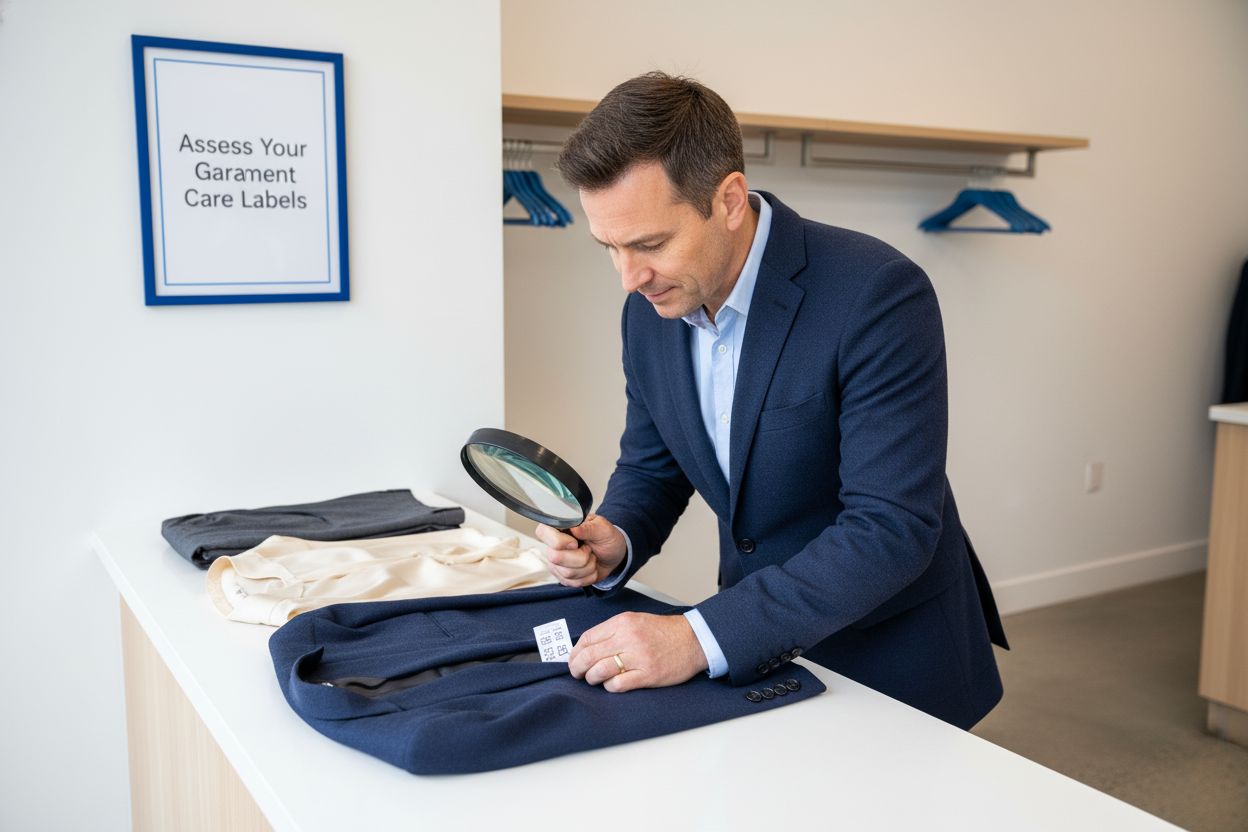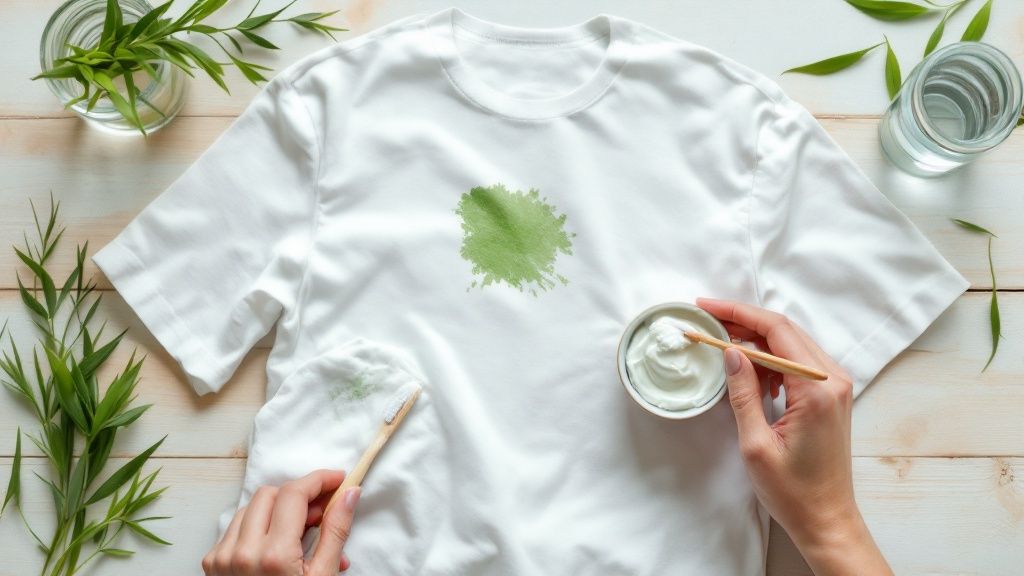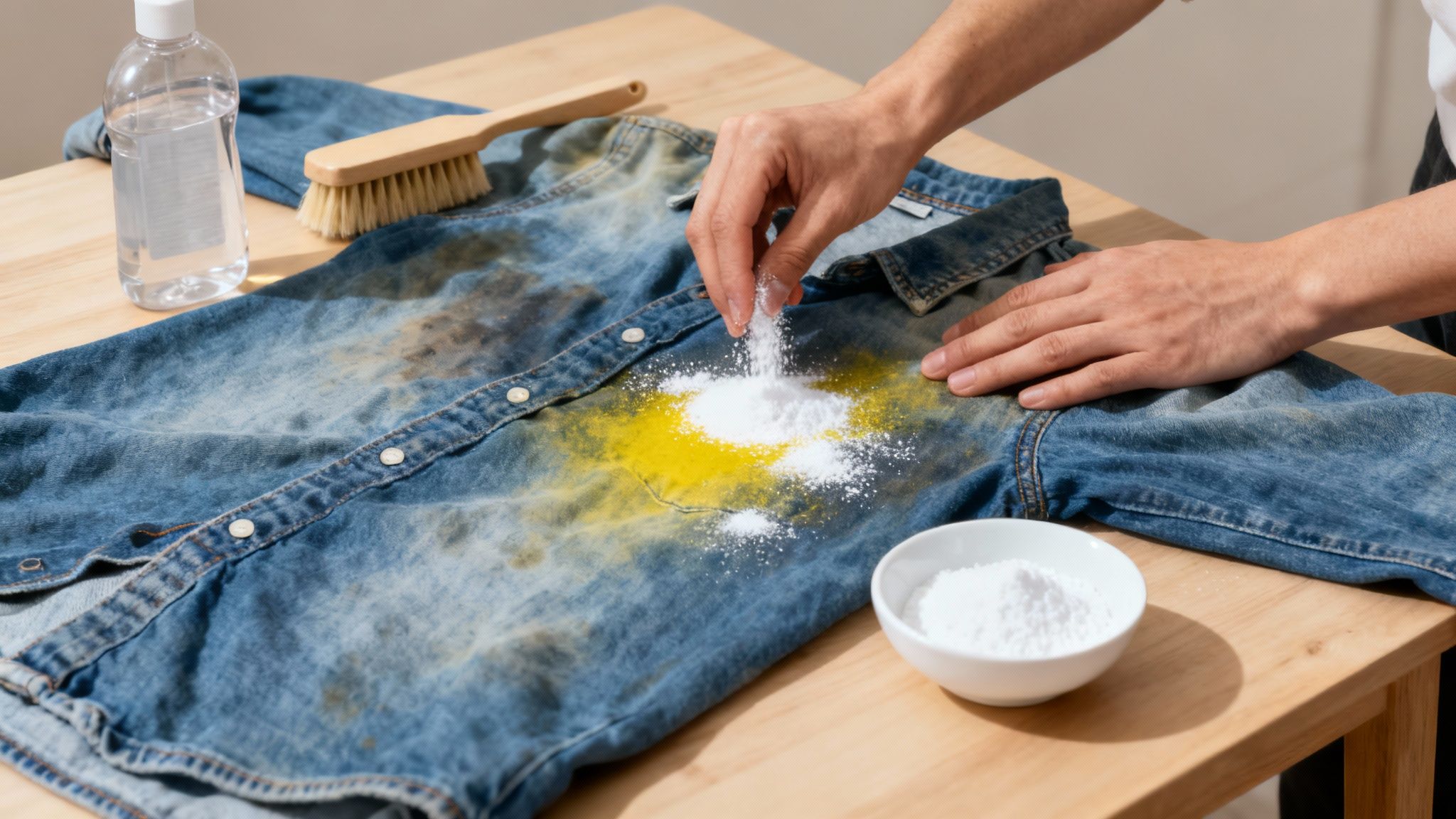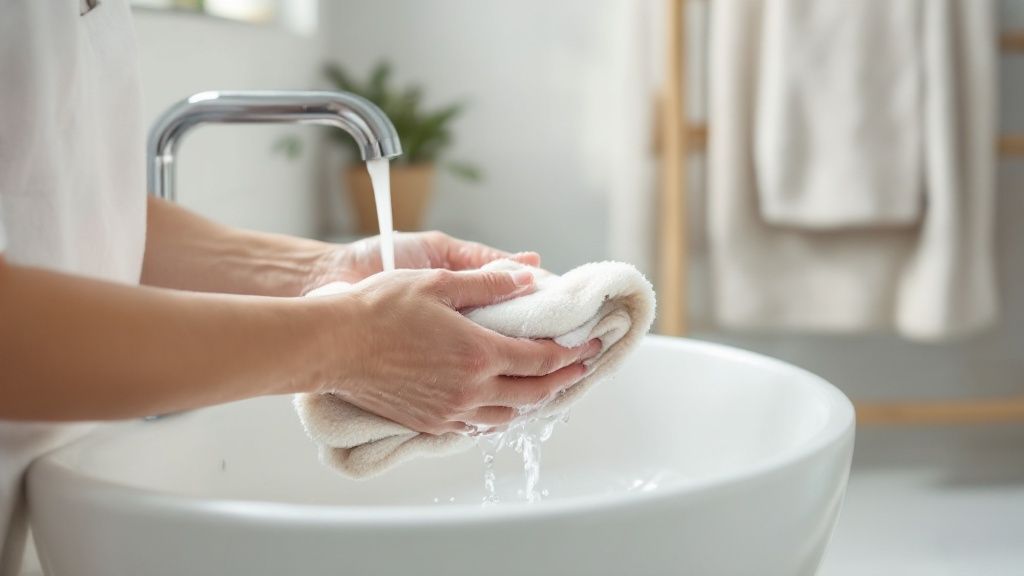A Practical Guide to Super Glue Remover for Clothes
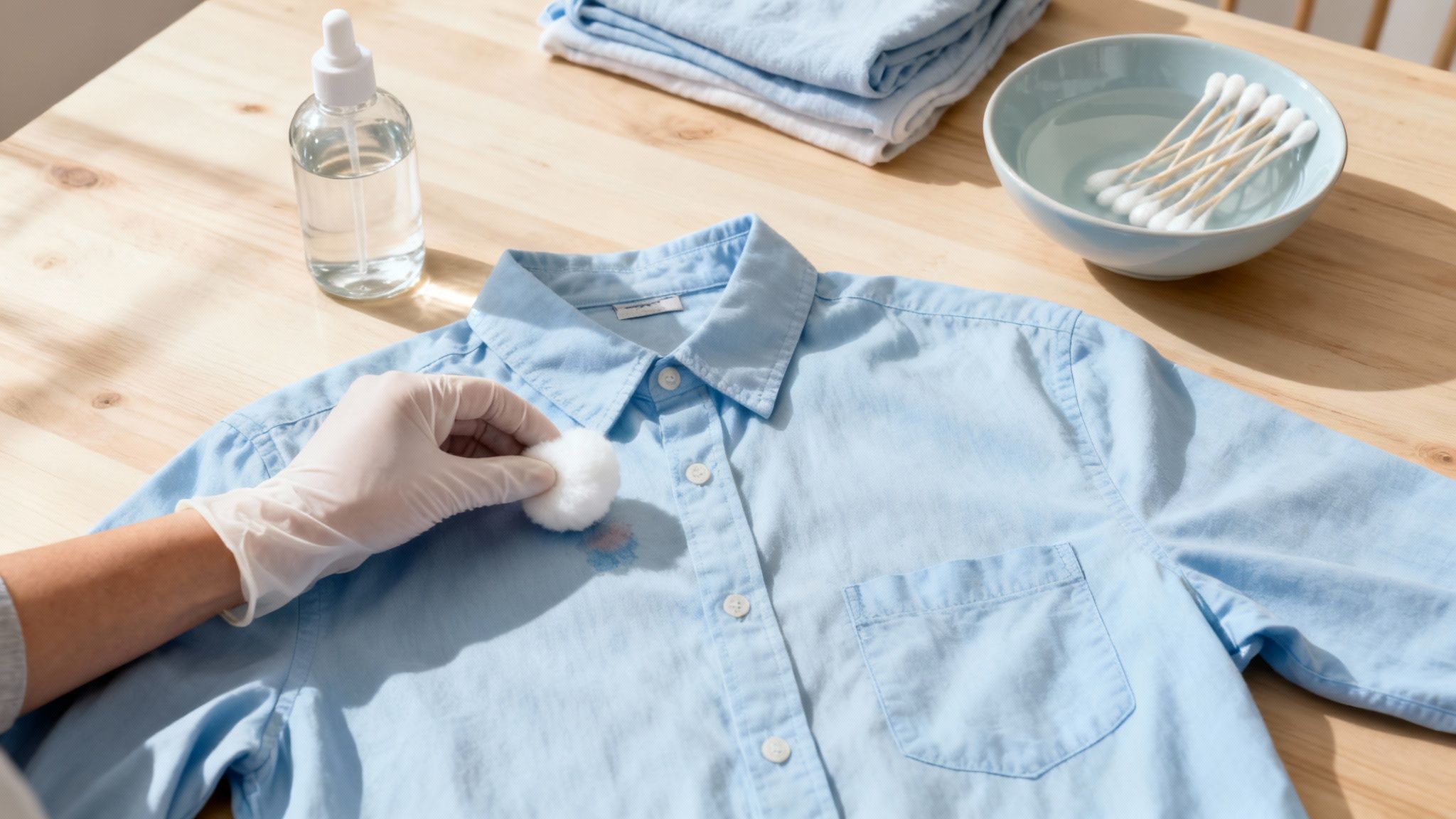
When super glue lands on your favorite shirt, the clock starts ticking. Your first move is what really counts, because acting fast—before the glue has a chance to fully set—can make all the difference between a minor cleanup and a permanent problem. The trick is to gently get rid of any excess glue on the surface and then prep the area for a more targeted treatment.
Your First Response to a Super Glue Spill
We’ve all been there. That heart-sinking moment when a drop of super glue escapes and lands squarely on your brand-new jeans. It’s easy to panic, but what you do in the next few moments will determine the fate of that garment. Before that glue forms a rock-hard, plastic-like bond with the fabric, you have a small window to get ahead of the problem.
Here’s your immediate game plan.
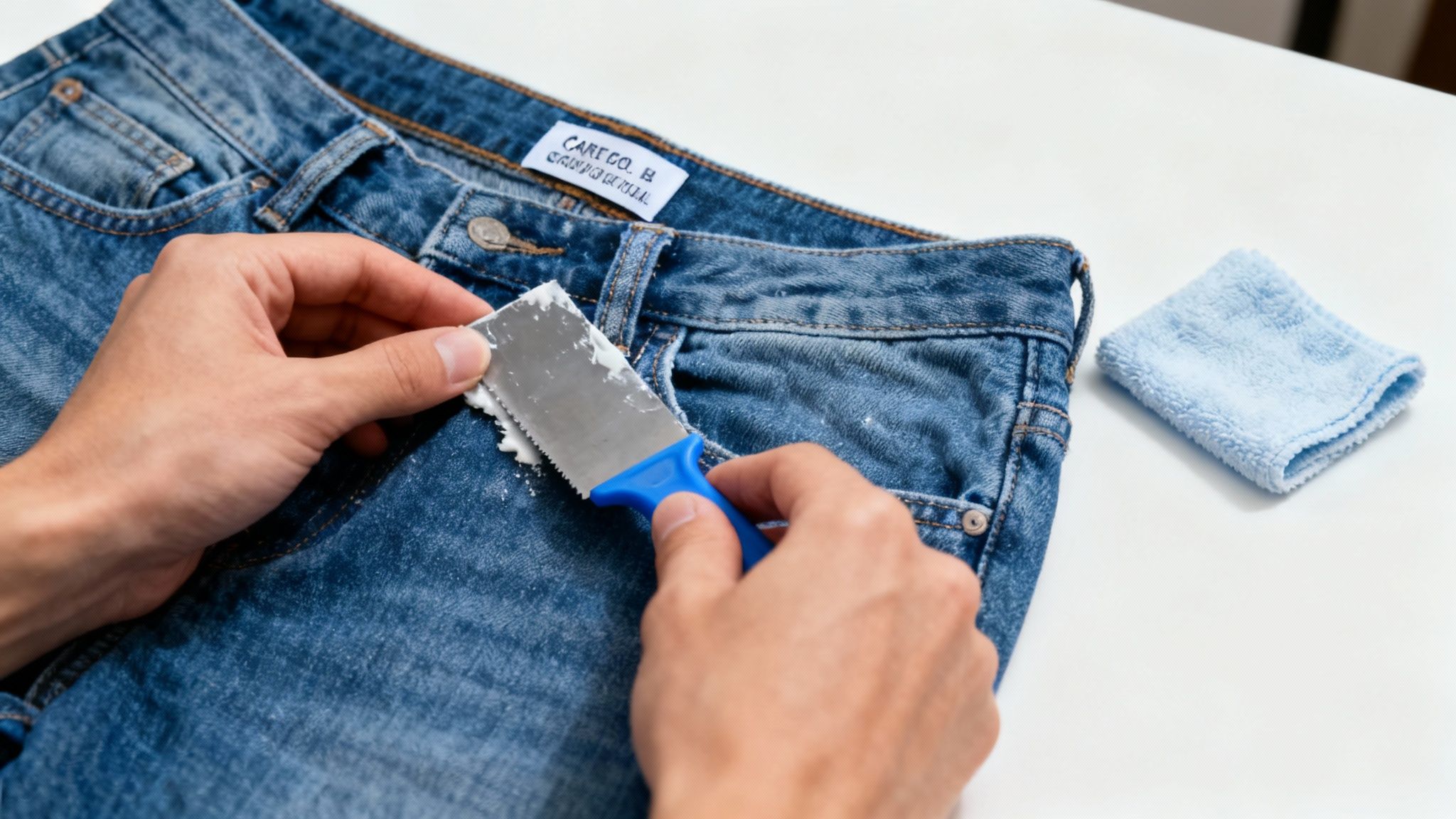
Assess the Spill and Fabric
First things first: whatever you do, don't wipe it. Wiping will only smear the adhesive, pushing it deeper into the fabric’s weave and turning a small spot into a much bigger headache. Instead, lay the item on a flat surface. Grab a dull butter knife or the edge of an old credit card and gently lift away any blob of excess glue sitting on top. Your goal is to remove as much as you can without applying any pressure.
Next, take a look at what you’re working with. Is it a rugged cotton t-shirt, a pair of sturdy jeans, or something delicate like a silk blouse? The type of fabric dictates your entire strategy from here on out. Tougher materials can usually handle stronger solvents, but delicates need a much gentler touch. Checking the care tag isn’t just a suggestion—it’s a must-do before you reach for any kind of remover. For a deeper dive, you can check out our guide on how different stain removers work on various materials.
Critical First Step: Always, always test your cleaning solution on a hidden spot first, like an inside seam. This simple check can save your garment from accidental discoloration or, worse, permanent damage.
Preparing for Treatment
Once you've scraped off the excess and know your fabric type, you’re ready to get to work. This isn’t just damage control; it's about setting yourself up for success. And you're not alone in this—the global market for super glue is expected to hit about $3.7 billion by 2032, which tells you accidental spills on clothes happen all the time.
To help you make a quick and smart decision, I've put together a handy table. Think of it as your cheat sheet for matching the right remover to the right fabric so you can get the job done right.
Quick Guide to Super Glue Removers by Fabric Type
This table breaks down the best removers for common fabrics, giving you a fast look at their effectiveness and any risks involved. It's designed to help you choose the right approach without the guesswork.
Picking the right tool for the job is half the battle. This guide should point you in the right direction, but remember to always proceed with caution, especially with your favorite or more expensive clothing.
Why Super Glue is So Incredibly Stubborn on Fabric
Ever had that sinking feeling as a drop of super glue lands on your favorite jeans? It's a uniquely frustrating kind of spill. You quickly find out it’s not like coffee or wine; it’s a whole different beast. The reason it’s so tough to get out comes down to a bit of rapid-fire chemistry happening right on the threads of your clothes.
The secret ingredient in super glue is something called cyanoacrylate. In the tube, it’s just a liquid monomer. But the second it comes into contact with even the tiniest amount of moisture—which is always present in the air and on surfaces like fabric—it triggers a process called polymerization.
Think of it this way: it’s like instantly snapping together thousands of microscopic LEGOs to create a solid, rigid piece of plastic. This isn't just a sticky mess sitting on top of the fabric. It's a new, hard polymer that has physically wrapped itself around and locked onto the individual fibers.
The Science Behind That Rock-Hard Spot
When cyanoacrylate meets moisture, it kicks off a chain reaction, forming long, tough polymer chains that harden in seconds. This is why super glue stains feel stiff and plasticky almost immediately. It’s a complete chemical transformation, and it's the reason a simple wash cycle won't even touch it. You can get a deeper dive into the nitty-gritty of these adhesives by exploring the challenges of super glue removal.
This powerful bond has a few key traits that make it so challenging:
- It’s Unbelievably Fast: The reaction starts the moment the glue hits the fabric. You have almost no time to just wipe it away before it begins to cure.
- It’s a Physical Bond: The hardened glue isn’t just staining the color of the fabric; it's physically grabbing onto the fibers, fusing them into a solid mass.
- It’s Water-Resistant: Once that polymer has hardened, it’s not going anywhere with just water. That’s why your washing machine often feels like it's done absolutely nothing.
So, Why Do You Need a Solvent?
Because you're not dealing with a typical stain, you can't just "wash" it out. Your real goal is to dissolve the hardened plastic. To do that, you need a specific super glue remover for clothes—a solvent that's capable of breaking down the polymer chains of the cyanoacrylate.
The Bottom Line: You're not fighting a stain. You're trying to reverse a chemical reaction by dissolving a new piece of plastic that has tangled itself in your fabric's fibers.
This is exactly why something like acetone works so well. Acetone is a powerful solvent that's perfect for breaking apart these specific polymer bonds. It essentially melts the hard plastic back into a gooey, softer state, allowing you to carefully lift it away from the fabric. Without a solvent, you’re just scraping away at a tiny piece of plastic fused to your clothes.
Using Acetone for Super Glue Removal on Sturdy Fabrics
When you’re staring down a stubborn, rock-hard super glue stain on tough fabrics like cotton or denim, it’s time to reach for the most effective at-home solution: acetone.
Acetone, the main ingredient in most nail polish removers, is a powerhouse solvent. It’s fantastic at breaking down the cyanoacrylate bonds that make super glue so... super. But that strength is also its biggest risk. Use it the wrong way, and you could end up with a discolored patch that’s way worse than the original glue spot.
Handled with care, though, it's the best super glue remover for clothes you'll find in your medicine cabinet. This process is all about patience and precision, not brute force.

The All-Important Spot Test
Before you even think about putting acetone on that visible stain, you have to do a spot test. Seriously, this step is non-negotiable.
Find a hidden area on the garment, like an inner seam or the inside of a hem. Grab a cotton swab, apply a tiny bit of acetone, and just wait a few minutes. Check for any color bleeding or weird changes to the fabric. If it looks exactly the same, you’re good to go. If not, stop right there and switch to a gentler method.
The principle here is all about using the right solvent carefully, which is similar to other tough cleaning jobs like removing sticky road tar from car paint. In both situations, the goal is to dissolve a stubborn substance without wrecking the surface underneath.
Application and Removal Technique
Once you’ve confirmed the fabric can handle it, lay the stained part of your garment flat. Place a paper towel or an old white cloth underneath it to soak up the dissolved glue and stop it from spreading.
Now, take a fresh cotton ball or swab and gently dab the acetone directly onto the hardened glue. Don't rub or scrub! Your goal is just to saturate the glue and let the acetone do its job softening the bond. You should start to see the edges of the glue loosen up and turn a whitish color.
After a few minutes, grab a dull-edged tool—a butter knife, an old credit card, or even your fingernail works. Gently start to pry or scrape at the softened glue, working from the outside edges inward. You might have to apply a little more acetone and repeat this a few times.
Key Takeaway: Patience is your best friend here. Rushing things and rubbing aggressively will just damage the fabric fibers. Let the acetone dissolve the glue, then gently lift it away.
Post-Treatment and Final Wash
After you’ve scraped off all the solid bits of glue, you might still see a faint residue. You can tackle this by mixing a little bit of laundry detergent with water to create a pre-treatment paste. Gently rub this into the spot.
Finally, toss the garment in the wash and follow its care label instructions. And here's a crucial tip: before you even think about putting it in the dryer, inspect the area one last time. Make absolutely sure every trace of the glue is gone. The heat from a dryer can set any remaining residue, making it nearly impossible to remove later on.
Acting fast makes a huge difference, too. Research shows that using an acetone-based solvent within the first 10 minutes of a spill can get rid of up to 85% of a super glue stain on cotton. If you wait even an hour, that success rate can drop below 40%.
Safer Super Glue Removal for Delicate Materials
When super glue lands on a sturdy cotton t-shirt, you have options. But what about that silk blouse you love or a favorite wool sweater? For these delicate items, acetone is completely off the table—it can dissolve or discolor sensitive fibers in a heartbeat.
This is when you need to turn to a gentler, safer super glue remover for clothes from your own pantry. Don't worry, you have a reliable plan B for the more precious garments in your closet. Household staples like white vinegar and rubbing alcohol can work wonders, as long as you approach the task with a little extra patience.
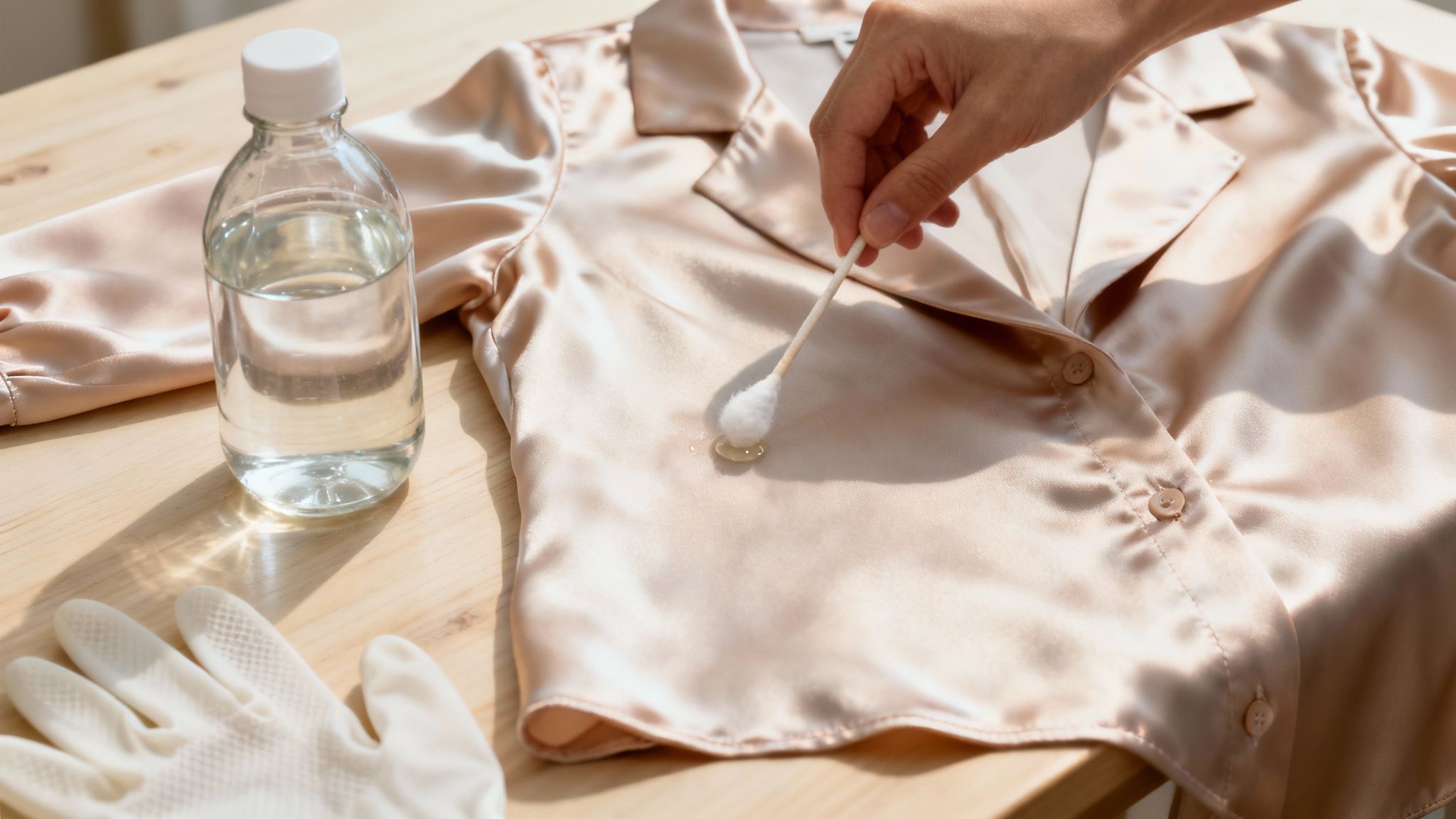
Gentle Solvents You Already Own
Instead of reaching for harsh chemicals, we'll be using mild acids and alcohols to slowly break down the glue’s bond without harming the fabric itself. The key is to work slowly and carefully, giving these gentler solutions the time they need to do their job.
- White Vinegar: The mild acetic acid in white vinegar is surprisingly effective. It slowly penetrates the hardened cyanoacrylate, softening it from the edges inward. It's an excellent first choice for natural fibers like wool and silk.
- Rubbing Alcohol (Isopropyl Alcohol): This acts as a less aggressive solvent than acetone. It's often safer for synthetic delicates like rayon or certain blends, but a spot test is still an absolute must.
For fabrics like silk, which need specialized care even on a good day, a DIY approach can feel a bit risky. If the garment is valuable, understanding the complexities of professional silk dry cleaning can help you decide when it's better to call in the experts.
Expert Tip: Never use heat on delicate fabrics like silk or wool to try and soften super glue. High temperatures from an iron or hairdryer can permanently set the stain or even damage the fibers, causing them to shrink or scorch long before the glue gives way.
Comparing Acetone-Free Super Glue Removers
So, which gentle solution should you try first? Both white vinegar and rubbing alcohol have their place, but they work a bit differently. This quick table breaks down their strengths.
As you can see, your fabric type is the biggest factor. Vinegar is a go-to for natural fibers, while rubbing alcohol often performs better on synthetics.
To use either of these methods, grab a cotton ball, apply the liquid, and gently dab—never rub!—the glue spot. You need to let it sit for several minutes to penetrate the glue. Then, use a soft-bristled toothbrush or even your fingernail to gently flake away the softened bits.
You will almost certainly need to repeat this process several times. Patience really is the most important tool you have when working with delicate materials. After you’ve successfully removed the glue, rinse the area with cool water before washing as usual.
Knowing When to Trust a Professional Cleaner
You’ve tried everything. You’ve been patient, you’ve followed the steps, but that super glue spot just isn’t going anywhere. We’ve all been there. Sometimes, the smartest thing you can do isn't to try another home remedy—it's to know when to stop and call in a professional. Pushing a DIY solution too far can quickly turn a small, fixable stain into permanent damage, especially if you're working with delicate or expensive clothing.
Deciding to hand over your garment can feel like giving up, but there are some clear red flags that make the choice obvious. Learning to spot them is the key to saving a piece you really love.

Signs It's Time for Professional Help
Take a good look at the garment itself. Is it that vintage silk scarf you inherited? A tailored wool blazer you splurged on? A designer dress that would be impossible to replace? These kinds of items are often made from materials that can react in very unpredictable ways to the solvents you have at home. The risk of causing discoloration, shrinkage, or weird texture changes is just too high.
Think of these situations as clear signals to get an expert involved:
- The Fabric is High-Risk: Materials like velvet, suede, leather, and silk need specialized care. A professional has access to solvents specifically formulated to be tough on glue but gentle on these exact fibers.
- The Stain is Large or Deeply Set: A tiny, fresh drop of glue is one thing. A big spill that has fully cured and hardened deep into the fabric's weave is a whole other beast. Pros have the tools to tackle these stains without harming the surrounding area.
- The Garment is Sentimental or Expensive: If the item means a lot to you—whether emotionally or financially—don't gamble with it. The cost of a professional cleaning is a small price to pay to make sure it's preserved.
When you're dealing with a tough stain, it often comes down to weighing DIY against professional cleaning services. Even if the context is a bit different, the logic holds up: professionals bring specialized equipment and knowledge that you just can't replicate at home.
Bringing your garment to a professional isn't admitting defeat; it's a strategic move to save it from permanent harm. Expert cleaners can identify fabric composition and use the precise super glue remover for clothes that will be most effective.
The Professional Advantage
So, what exactly makes a professional cleaner so much better at this? It really comes down to their arsenal of tools and years of experience. They use specialized, industry-grade solvents that are way more powerful and targeted than the acetone or rubbing alcohol you have under your sink. These chemicals are designed to break down cyanoacrylate (the sticky stuff in super glue) without stripping color or weakening the fabric. You can learn more about how expert cleaners successfully remove a wide variety of stains in our detailed guide.
Here at Columbia Pike Laundry, we see these kinds of tough situations every single day. Our team is trained to assess the fabric, the glue, and the best way forward. And with our convenient pickup and delivery, you don’t even have to leave the house. We’ll pick up your garment, give it the expert care it needs, and bring it back to you, saving you the stress and potential heartbreak of a DIY disaster.
Common Questions About Getting Super Glue Out of Clothes
Even with the best plan, you're bound to have a few questions. And when you’re up against something as tough as super glue, you want to be 100% sure before you start dabbing solvents on your favorite jeans. We get it.
Think of this as your go-to guide for those last-minute "what ifs." We'll walk through the most common concerns we hear from our customers, giving you that extra bit of confidence to get the job done right.
Can I Use Rubbing Alcohol Instead of Acetone?
Absolutely. Rubbing alcohol is a fantastic, milder alternative to acetone, making it a much safer bet for delicate fabrics. It’s a less aggressive solvent, which just means you’ll need a bit more patience for it to work its magic as a super glue remover for clothes.
Simply soak a cotton ball with the alcohol and dab it onto the hardened glue. Give it a good five to ten minutes to sit and soften the adhesive. After that, you should be able to gently scrape or peel away the loosened bits. But just like with any solvent, always do a quick spot test on an inside seam first—it can still cause some dyes to run.
What Happens If I Wash Clothes with Super Glue on Them?
This is a classic mistake, and unfortunately, one that won't get you anywhere. Throwing a garment with hardened super glue into the wash will, in most cases, do absolutely nothing to the stain. The glue's polymer bond is designed to be water-resistant, so it will likely come out of the washing machine looking exactly the same as it went in.
Worse yet, the intense heat from a machine dryer can actually cause the cyanoacrylate to fuse even more deeply into the fabric's fibers. This chemical reaction can set the stain permanently, making it nearly impossible to remove later. It is crucial that you treat and remove the glue before the item ever sees the inside of a washer and dryer.
Crucial Takeaway: Heat is your enemy when dealing with a super glue stain. Always treat the spot first and let the garment air-dry until you are positive the glue is gone. Only then should you consider using a machine dryer.
Will Super Glue Remover Damage My Washing Machine?
It’s a fair question, but you can put your mind at ease. Once you've successfully treated the stain and scraped off all the solid, flaky bits of glue, the microscopic residue left behind is far too small to cause any trouble for your washing machine.
Any lingering solvent or dissolved glue will be so heavily diluted in the wash water that it becomes completely harmless. If you're still worried, just give the treated area a good rinse under cold running water before tossing it in the machine. This will flush away any excess remover before it even has a chance to enter your washer.
How Do I Safely Get Super Glue Off My Skin?
First things first: don't panic and don't try to pull your skin apart. This can easily tear your skin and cause a lot of unnecessary pain.
Instead, here’s a much safer approach:
- Soak the area in warm, soapy water for several minutes to start loosening the bond.
- Gently rub an oily substance—like petroleum jelly, vegetable oil, or even hand lotion—onto the spot. The oils are great at breaking down the adhesive.
- For really stubborn spots, you can use a tiny bit of acetone (nail polish remover). Apply it carefully with a cotton swab, and be sure to wash and moisturize your skin thoroughly afterward.
When a DIY fix just isn't cutting it, or the garment is too precious to risk, Columbia Pike Laundry is here to step in. Our pros have the experience and professional-grade solvents to tackle even the most hopeless super glue stains, saving your clothes and your peace of mind. Schedule your first pickup today and let us handle the tough stuff.
Popular Blog Articles

Meet the Author
Daniel Logan didn’t start CPL because he loved laundry. He started it because his family was drowning in time debt, and laundry was one of the biggest weights.
Mornings were chaos with two kids under 5. Evenings felt like catch-up. And weekends? Gone to sorting socks and folding piles.
He knew his story wasn’t unique. So he built a business that gave families like his just a little bit of breathing room one load at a time.
With no laundry experience but deep tech skills, Daniel rolled up his sleeves, doing every job himself while building systems that turned it into a modern laundry service that saves customers time, simplifies their lives, and delivers reliability they can count on.
That’s where CPL began. Not from a playbook, but from pain. From one dad trying to buy back time: for himself, and for every household like his.


